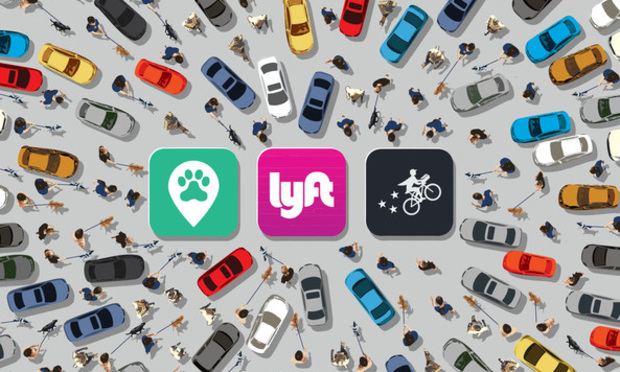 Legal questions focused on worker classification take on special significance in a state where some of the biggest and most visible on-demand companies were founded.
Legal questions focused on worker classification take on special significance in a state where some of the biggest and most visible on-demand companies were founded.
The California Supreme Court used real-world examples to explain its highly anticipated ruling that adopted a more structured test for how companies must classify their workers: A plumber who's hired to fix a problem in a retail store is an independent contractor. A cake decorator at a bakery should be considered an employee.
The ruling, with wide implications for the gig economy, put in place a new test that uses three distinct factors to determine whether a worker is an employee or an independent contractor. Monday's decision changes the standard from the more flexible one that had been used in the state since 1989.
Legal questions focused on worker classification take on special significance in a state where some of the biggest and most visible on-demand companies were founded. The business models for many app-centered companies that say they employ contractors, not employees, do not fit neatly into the categories outlined in the real-world examples explained by the court. The stakes are high—employees are entitled to certain benefits, such as minimum wage and workers' compensation.
Related: Gig workers: who are they and how much do they get paid?
Companies across the state are expected to re-evaluate their own workforces, and the foundation of contractor-based business models will be tested, employment attorneys told The Recorder in interviews. The number of class actions is anticipated to balloon.
The “ABC” classification test, adopted by the California court, says an independent contractor is a worker who is free from the control and direction in performing the work; the worker performs work that is outside the usual course of the business; and the worker is “customarily engaged in an independently established trade, occupation, or business” of the same nature as the work performed by the hiring entity.
What follows are three considerations that attorneys and companies are facing now.
1. The gig economy will have to defend its business model. And it won't be easy.
The gig economy's structure is at stake. The new test will make it more difficult for companies to defend classifying workers as independent contractors.
Two of the “ABC” factors could be problematic. The first factor of exercising control is fairly straightforward and commonly argued during litigation—companies contend their contractors are free to work as little or as much as they want. That's one of the main selling points for signing up to drive for, say, Uber or Lyft.
But the second factor—requiring that the performed work be outside the company's chief business—is trickier.
App-based companies that hire workers such as drivers or delivery personnel as independent contractors could argue they are not transportation or food delivery companies, but rather their business is technology and their product an app.
“If you are a delivery-type person and you are delivering food, would the delivery be part of the business of that entity? If you cast a critical eye to that, that type of delivery person might be an employee,” said Tim Long, a partner at Orrick, Herrington & Sutcliffe in Los Angeles.
The third factor is a puzzle, as well, and it's unclear how strictly the court will interpret the requirement that the worker has an established trade or occupation that fits the business model. Many people employed by gig companies do not consider themselves as having their own separate business entity.
“You had better look very carefully at every one of your classifications,” Long said. “This case raises heightened awareness. If you don't do it, you are taking a big chance.”
Kimberly Chase, a partner in the Orange County office of Haynes and Boone, said gig economy companies will look closely at whether they need to reclassify their workers as employees.
“Things will get more expensive and hoops to jump through in terms of how they run things,” Chase said. “It will be heavily litigated. The gig companies, such as Uber, might say, 'We are an app. We provide an app, we don't provide driving services. We never touch the food. We don't own the cars.”
2. Litigation is certain to increase. The interpretation of the test is still to be determined.
There has been no shortage of litigation over worker classification questions, and the sharing economy fostered even more cases and controversies. Federal and state judges around the country are being presented these issues, and the California ruling could ramp up disputes.
“There is still a lot of uncertainty,” said Zach Hutton, a Paul Hastings partner in San Francisco. “The courts will determine what it means to perform work within the usual course of business, for example. I don't think will be the end of the litigation.”
Hutton said new litigation will guide companies on the parameters of the worker classification test.
Anne Barnett, principal at Polsinelli in San Francisco and Los Angeles, said the boundaries of the “ABC” test are not clear. Companies with deeper pockets might test the waters.
“The reality is that the justices didn't use examples that are really modernized or relevant to the gig economy,” Barnett said. “Ultimately there will be an influx in litigation, particularly class actions. As a result, we'll have better boundaries of the test.”
3. Employers across the state will re-evaluate their workforces. Is clarity a silver lining for companies?
Long of Orrick put it like this: “What should companies be doing? Evaluating all their independent contractor classifications with critical eyes. The Supreme Court made it clear the burden is on the employer. Any responsible hiring entity should take to heart what the court is changing. They will be facing tough decisions.”
For all companies, the Supreme Court's ruling could provide certainty, said Travis Gemoets, partner at Jeffer Mangels Butler & Mitchell in Los Angeles. Gemoets said even though it's not necessarily cut and dry, the test can provide a blueprint for even gig economy companies.
“Now that this is the law of the land, businesses can say, 'Hey mine fit,'” Gemoets said. “Some of them will not and they will adjust. If they don't fit in the nice neat categories, they can re-classify or figure out a way to get them to fit.”
Hutton of Paul Hastings said companies will be looking specifically at vendor relationships. This may result in switching workers to employee status or businesses may create ways to screen these relationships moving forward to make sure they comply.
“I'm not sure there is a one-size-fits-all answer,” Hutton said. “It's certainly a stricter test with the three elements, but I don't agree that in all cases that the outcome will be determinative.”
Barnett of Polsinelli said the case will lead to “sweeping changes in how employees look at classifying their employees.” She said in California there is significant risk of wage-and-hour compliance issues.
“Employers have to go back to the drawing board to determine the extent they can change their business models or work around the new test,” she said. “It's such a significant piece of their business model. Many will not just abandon it but figure out a way to adapt.”
© 2025 ALM Global, LLC, All Rights Reserved. Request academic re-use from www.copyright.com. All other uses, submit a request to [email protected]. For more information visit Asset & Logo Licensing.







